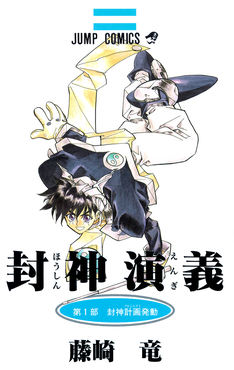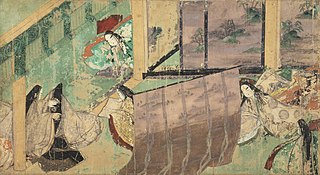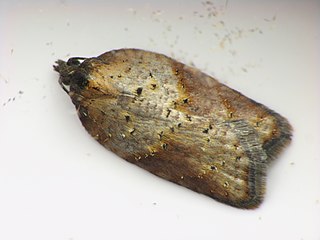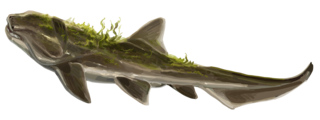
The Tortricidae are a family of moths, commonly known as tortrix moths or leafroller moths, in the order Lepidoptera. This large family has over 11,000 species described, and is the sole member of the superfamily Tortricoidea, although the genus Heliocosma is sometimes placed within this superfamily. Many of these are economically important pests. Olethreutidae is a junior synonym. The typical resting posture is with the wings folded back, producing a rather rounded profile.

Hoshin Engi is a Japanese manga series written and illustrated by Ryu Fujisaki, inspired by the Chinese literary classic Investiture of the Gods, a shenmo novel. The manga was serialized in Shueisha's shōnen manga magazine Weekly Shōnen Jump from June 1996 to November 2000, with its chapters collected in 23 tankōbon volumes. The story involves Chinese mythology and history of China, in particular the last members of the Yin dynasty, and the plot to overthrow them. In North America, the manga was licensed for English release by Viz Media. Fujisaki also wrote a short gaiden manga, titled Hoshin Engi Gaiden: Senkai Dōsho, serialized in Weekly Young Jump from April to June 2018.

Illustrated handscrolls, emakimono, or emaki (絵巻) is an illustrated horizontal narration system of painted handscrolls that dates back to Nara-period Japan. Initially copying their much older Chinese counterparts in style, during the succeeding Heian (794–1185) and Kamakura periods (1185–1333), Japanese emakimono developed their own distinct style. The term therefore refers only to Japanese painted narrative scrolls.

The Archipini are a tribe of tortrix moths. Since many genera of these are not yet assigned to tribes, the genus list presented here is provisional.

The Shigisan Engi Emaki is an emakimono or emaki made in the second half of the 12th century CE, during the Heian period of Japanese history (794–1185). It is an illuminated manuscript detailing miracles attributed to the monk Myōren, who lived on Mount Shigi near Nara in Japan in the latter part of the 9th century.
Asterolepis is a genus of moths belonging to the subfamily Tortricinae of the family Tortricidae.

The Euliini are a tribe of tortrix moths.

The Tortricini are a tribe of tortrix moths.

Acleris hastiana is a moth of the family Tortricidae. It is found in Europe, northern Iran, Kazakhstan, Ala Tau, central Siberia, Irkutsk, the Amur region and China. In North America it is found from the north-eastern United States across southern Canada to British Columbia and south along the Pacific Coast to California.

Acleris ferrugana is a species of moth of the family Tortricidae. It is found in China, most of Europe and has also been recorded from North America.
Asterolepis may refer to:
Alexey Nikolaievich Diakonoff, also transliterated as Alexej Nikolajewitsch Diakonoff, was a Russian–Dutch entomologist who specialised in Microlepidoptera.
Asterolepis brandti is a species of moth of the family Tortricidae. It is found in Papua New Guinea.
Asterolepis dipterocarpi is a species of moth of the family Tortricidae. It is found in Brunei. The habitat consists of dipterocarp forests.
Asterolepis cypta is a species of moth of the family Tortricidae. It is found in Brunei. The habitat consists of dipterocarp forests.
Asterolepis chlorissa is a species of moth of the family Tortricidae. It is found in Indonesia (Moluccas).
Asterolepis earina is a species of moth of the family Tortricidae. It is found in Australia, where it has been recorded from Queensland.
Asterolepis glycera is a species of moth of the family Tortricidae. It is found in Australia, where it has been recorded from Queensland.

Engis 2 refers to part of an assemblage, discovered in 1829 by Dutch physician and naturalist Philippe-Charles Schmerling in the lower of the Schmerling Caves. The pieces that make up Engis 2 are a partially preserved calvaria (cranium) and associated fragments of an upper and a lower jaw, a maxillary bone and an upper incisor tooth of a two to three year old Neanderthal child. The Schmerling Caves are situated just north of the Belgian municipality Engis, whence the name of this group. In 1833 Schmerling described and publicized the find, which included animal bones and stone tools. Recognizing their old age, he associated them with the "Ethiopian Type" of the diluvial period. Although it was not recognized as such until 1936, the publication represents the first scientific description of a Neanderthal fossil.

Heterosteus is an extinct genus of heterosteid placoderm of the Middle Devonian known from remains discovered in Europe and Greenland. According to Denison, 1978, Heterosteus might have been planktivorous, along with Homosteus, and Titanichthys.










